###Synopsis###
Synopsis
###Circularly symmetric distributions###
Circularly symmetric distributions
###How to Create Ellipses###
How to Create Ellipses
###Application###
Application
###Conclusions###
Conclusions
###Technical Notes###
Stack Exchange network consists of 183 Q&A communities including Stack Overflow, the largest, most trusted online community for developers to learn, share their knowledge, and build their careers.
Visit Stack ExchangeTeams
Q&A for work
Connect and share knowledge within a single location that is structured and easy to search.
Learn more about Teams###Synopsis###
###Circularly symmetric distributions###
###How to Create Ellipses###
###Application###
###Conclusions###
###Technical Notes###
###Synopsis###
###Circularly symmetric distributions###
###How to Create Ellipses###
###Application###
###Conclusions###
###Technical Notes###
This is a skew transformation. It actually does two things at once:
It squeezes in the $y$ direction (by an amount $\lambda$, say). This leaves the $x$-axis alone.
It lifts any resulting point $(x,y)$$(x,\lambda y)$ by an amount directly proportional to $x$. Writing that constant of proportionality as $\rho$, this sends $(x,y)$$(x,\lambda y)$ to $(x, y+\rho x)$$(x, \lambda y+\rho x)$.
This is a skew transformation. It actually does two things at once:
It squeezes in the $y$ direction (by an amount $\lambda$, say). This leaves the $x$-axis alone.
It lifts any resulting point $(x,y)$ by an amount directly proportional to $x$. Writing that constant of proportionality as $\rho$, this sends $(x,y)$ to $(x, y+\rho x)$.
This is a skew transformation. It does two things at once:
It squeezes in the $y$ direction (by an amount $\lambda$, say). This leaves the $x$-axis alone.
It lifts any resulting point $(x,\lambda y)$ by an amount directly proportional to $x$. Writing that constant of proportionality as $\rho$, this sends $(x,\lambda y)$ to $(x, \lambda y+\rho x)$.
The mean formula is a###Synopsis###
Every statement in the question can be understood as a property of ellipses. The only property of ellipses. Ellipses show up becauseparticular to the bivariate Normal distribution that is actuallyneeded is the fact that in a circularly symmetric distributionstandard that has been distorted in a simple way: namely, by rescaling its axesbivariate Normal distribution of (separately)$X,Y$--for which $X$ and rotating it (an$Y$ are uncorrelated--the conditional variance of affine transformation)$Y$ does not depend on $X$. These facts alone make it intuitively obvious(This in turn is an immediate consequence of the fact that lack of correlation implies independence for jointly Normal variables.)
The following analysis shows precisely what property of ellipses is involved and derives all the conditional expectationequations of onethe question using elementary ideas and the simplest possible arithmetic, in a way intended to be easily remembered.
###Circularly symmetric distributions###
The distribution of the variablesquestion is a member of the family of bivariate Normal distributions. They are all derived from a basic member, the muststandard bebivariate Normal, which describes two uncorrelated standard Normal distributions (forming its two coordinates).
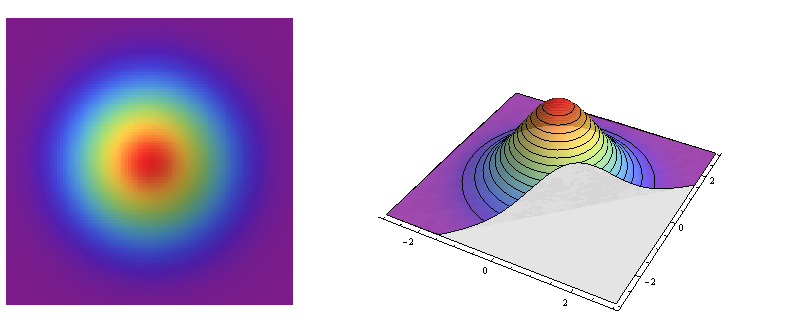
The left side is a relief plot of the standard bivariate normal density. The right side shows the same in pseudo-3D, with the front part sliced away.
This is an example of a circularly symmetric distribution: the density varies with distance from a linear function ofcentral point but not with the other variable anddirection away from that point. Thus, the contours of its slope isgraph (at the right) are somecircles. function of
Most other bivariate Normal distributions are not circularly symmetric, however: their cross-sections are ellipses. These ellipses model the coefficientscharacteristic shape of the covariance matrix $\Sigma$many bivariate point clouds.
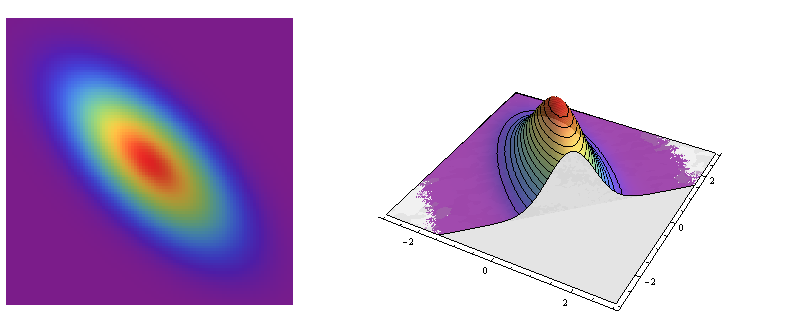
These are portraits of the bivariate Normal distribution with covariance matrix $\Sigma = \left(\begin{array}{cc} 1 & -\frac{2}{3} \\ -\frac{2}{3} & 1 \\\end{array}\right).$ It is a model for data with correlation coefficient $-2/3$.
###About affinely transformed circularly symmetric distributions######How to Create Ellipses###
When we reAn ellipse-express the variables $X_1$ and $X_2$ in terms of their standard deviations relative-according to their meansits oldest definition--thatis a conic section, which is a circle distorted by a projection onto another plane. By considering the nature of projection, whenjust as visual artists do, we use the variables $Z_i = (X_i - \mu_i)/\sqrt{\sigma_{ii}}$--the conditional distribution should have mean
$$\mathbb{E}(Z_2|Z_1) = \rho Z_1.$$may decompose it into a sequence of distortions that are easy to understand and calculate with.
First, stretch (I have reversedor, if necessary, squeeze) the variables in order to followcircle along what will become the conventional idea thatlong axis of the secondellipse until it is conditional on the first.correct length:

Next, squeeze (or stretch) This fact is what we aim to understand better.this ellipse along its minor axis:
Because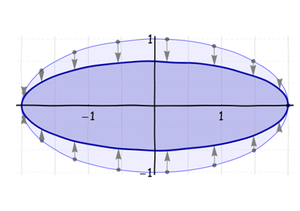
Third, rotate it is an affine transformation ofaround its center into its final orientation:
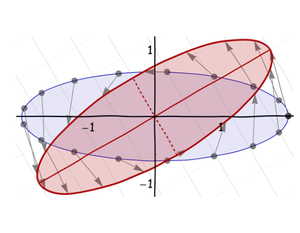
Finally, shift it to the circularly symmetric standard bivariate Normal distributiondesired location:
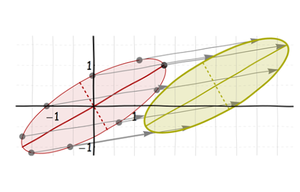
These are all affine transformations. (In fact, the contoursfirst three are linear transformations; the final shift makes it affine.) Because a composition of any bivariate Normal distribution must be affine transformations of circlesis (by definition) still affine, as shown in this pseudo-3D picture of its densitythe net distortion from the circle to the final ellipse is an affine transformation. But it can be somewhat complicated:

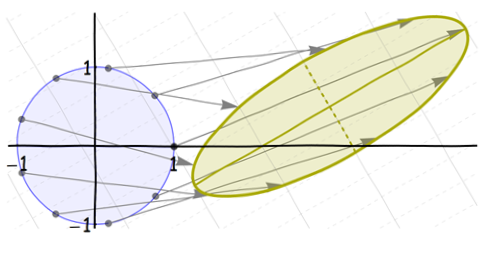
The $Z_2$ axis is horizontalNotice what happened to the ellipse's (natural) axes: after they were created by the shift and squeeze, they (of course) rotated and shifted along with the axis itself. We easily $Z_1$see these axes comes outeven when they are not drawn, because they are axes of symmetry of the screen towards youellipse itself.
We would like to apply our understanding of ellipses to understanding distorted circularly symmetric distributions, like the bivariate Normal family. Unfortunately, there is a problem with these distortions: they do not respect the distinction between the $x$ and $y$ axes. The rotation at step 3 ruins that. Look at the density axisfaint coordinate grids in the backgrounds: these show what happens to a grid (not labeledof mesh $1/2$ in both directions) when it is more or less "updistorted."
This In the first image has been cut off atthe spacing between the original vertical lines $Z_1 = 1$(shown solid) is doubled. The edge of In the cut, which formssecond image the front edge ofspacing between the surfaceoriginal horizontal lines (shown dashed) is shrunk by a third. In the third image the grid spacings are not changed, representsbut all the conditional density $Z_2|\{Z_1=1\}.$lines are rotated. They shift up and to the right in the fourth image. The peak offinal image, showing the net result, displays this edgestretched, squeezed, rotated, shifted grid. The original solid lines of constant $x$ coordinate no longer are vertical.
The key idea--whereone might venture to say it is highestthe crux of regression--is itsthat there is a way in which the circle can be distorted into an ellipse modewithout rotating the vertical lines. However, Because the symmetry ofrotation was the Normal distribution impliesculprit, let's cut to the modechase and show how to coincidescreated a rotated ellipse without actually appearing to rotate anything with its mean.!
###Studying conditional expectations###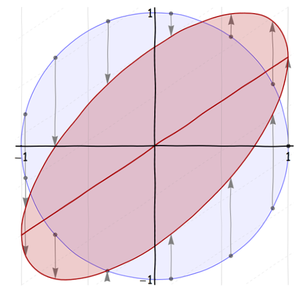
Let's varyThis is a $Z_1$ and keep track of the location ofskew transformation. It actually does two things at once:
It squeezes in the $y$ direction (by an amount $\lambda$, say). This leaves the $x$-axis alone.
It lifts any resulting point $(x,y)$ by an amount directly proportional to $x$. Writing that constant of proportionality as $\rho$, this sends $(x,y)$ to $(x, y+\rho x)$.
The second step lifts the peak of$x$-axis into the conditional density as we do so. Part of that track isline $y=\rho x$, shown by the white path in the previous figure. To show how it was constructed As shown in that figure, I have createdwant to work with a sequence of severalspecial skew transformation, one that effectively rotates the ellipse by 45 degrees and inscribes it into the unit square. The major axis of this ellipse is the cuts asline $Z_1$ varied from$y=x$. It is visually evident that $1/2$ through$|\rho| \le 1$. (Negative values of $5/2$$\rho$ tilt the ellipse down to the right rather than up to the right.) This is the geometric explanation of "regression to the mean."
Choosing an angle of 45 degrees makes the ellipse symmetric around the square's diagonal (part of the line $y=x$). To figure out the parameters of this skew transformation, displayed as contour mapsobserve:
The lifting by $\rho x$ moves the point $(1,0)$ to $(1,\rho)$.
The symmetry around the main diagonal then implies the point $(\rho, 1)$ also lies on the ellipse.
 Where did this point start out?
Where did this point start out?
The original (upper) point on the unit circle (having implicit equation $x^2+y^2=1$) with $x$ coordinate $\rho$ was $(\rho, \sqrt{1-\rho^2})$.
Any point of the form $(\rho, y)$ first got squeezed to $(\rho, \lambda y)$ and then lifted to $(\rho, \lambda y + \rho\times\rho)$.
In each oneThe unique solution to the equation $(\rho, \lambda \sqrt{1-\rho^2} + \rho^2) = (\rho, 1)$ is $\lambda = \sqrt{1-\rho^2}$. That is the amount by which all distances in the vertical direction must be squeezed in order to create an ellipse at a 45 degree angle when it is skewed vertically by $\rho$.
To firm up these ideas, here is a tableau showing how a circularly symmetric distribution is distorted into distributions with elliptical contours by means of these plots,skew transformations. The panels show values of $Z_1$ is on the horizontal axis$\rho$ equal to $0,$ $3/10,$ $6/10,$ and $Z_2$ on the vertical$9/10,$ from left to right. Colors represent the bivariate Normal density

The leftmost figure shows a set of starting points around one of the circular contours as well as part of the horizontal axis. Subsequent figures use arrows to show how those points are moved. The image of the horizontal axis appears as a slanted line segment (with slope $\rho$). (The colors represent different amounts of density in the different figures.)
###Application###
We are ready to do regression. A standard, elegant (for $\rho = 1/3$yet simple). The areas of saturated color are inside the contours just touching method to perform regression is first to express the peakoriginal variables in new units of measurement: we center them at their means and use their standard deviations as the cutsunits. The trace This moves the center of the peaks isdistribution to the slanted gray lineorigin and makes all its elliptical contours slant 45 degrees (up or down).
Because allWhen these picturesstandardized data form a circular point cloud, the regression is easy: the means conditional on $x$ are geometrically similar to each otherall $0$, forming a line passing through the origin. (relativeCircular symmetry implies symmetry with respect to the center$x$ axis, shownshowing that all conditional distributions are symmetric, whence they have $0$ means.) As we have seen, we may view the standardized distribution as a black dotarising from this basic simple situation in two steps: first, all the (standardized) $y$ values are multiplied by $\sqrt{1-\rho^2}$ for some value of $\rho$; next, thenall values with necessarily the trace-$x$-which passes throughcoordinates are vertically skewed by $\rho x$. What did these distortions do to the center--must be a straightregression line. (Euclid knew how to prove this visually evident fact.which plots the conditional means against $x$)?
###Properties of ellipses###
The shrinking of $y$ coordinates multiplied all vertical deviations by a constant. This merely changed the vertical scale and left all conditional means unaltered at $0$.
The vertical skew transformation added $\rho x$ to all conditional values at $x$, thereby adding $\rho x$ to their conditional mean: the curve $y=\rho x$ is the regression curve, which turns out to be a line.
The only question remaining concernsSimilarly, we may verify that because the slope of this line. Obviously$x$-axis is the slopeleast squares fit to the circularly symmetric distribution, the least squares fit to the transformed distribution also is less thanthe line $1:1$, because a$y=\rho x$: the least-squares line of that slope would coincidecoincides with the major axisregression line.
These beautiful results are a consequence of the ellipses andfact that the slope of this trace clearly has lesser magnitude.vertical skew transformation does not change any $x$ coordinates.
An affinely transformed circleWe can easily say more:
The first bullet (about shrinking) shows that when $(X,Y)$ has any circularly symmetric distribution, the conditional variance of $Y|X$ was multiplied by $\left(\sqrt{1-\rho^2}\right)^2 = 1 - \rho^2$.
More generally: the vertical skew transformation rescales each conditional distribution by $\sqrt{1-\rho^2}$ and then recenters it by $\rho x$.
For the standard bivariate Normal distribution, the conditional variance is--by definition--an ellipse a constant (equal to $1$), whence all these contours are ellipsesindependent of $x$. Not only We immediately conclude that after applying this skew transformation, because they are transformations of a collectionthe conditional variance of the concentricvertical deviations circles, they are concentric, have the same eccentricity,is still a constant and they shareequals $1-\rho^2$. Because the conditional distributions of a common majorbivariate Normal are themselves Normal, now that we know their means and minor axisvariances, we have full information about them.
NoticeFinally, we need to relate $\rho$ to the original covariance matrix $\Sigma$. For this, recall that the common major axis(nicest) definition of the ellipses lies incorrelation coefficient between two standardized variables $X$ and $Y$ is the expectation of their product $(1,1)$ direction$XY$. (The correlation of $X$ and $Y$ is simply declared to be the minor axis incorrelation of their standardized versions.) Therefore, when $(X,Y)$ follows any circularly symmetric distribution and we apply the skew transformation to the variables, we may write
$$\varepsilon = Y - \rho X$$
for the vertical deviations from the regression line and notice that $(1,-1)$ direction$\varepsilon$ must have a symmetric distribution around $0$. These are Why? Because principal directionsbefore for the bivariate densityskew transformation was applied, $Y$ had a symmetric distribution around $0$ and then we (a) squeezed it and (b) lifted it by $\rho X$. The covariance matrixformer did not change its symmetry while the latter recentered it at $\Sigma$$\rho X$, QED. The next figure illustrates this.
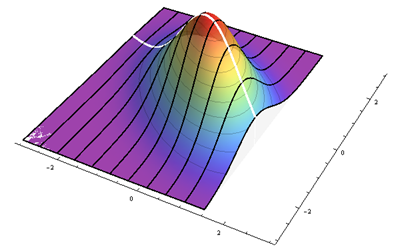
The black lines trace out heights proportional to the conditional densities at various regularly-spaced values of $x$. The thick white line is the regression line, which passes through the center of symmetry of each conditional curve. This plot shows the case $\rho = -1/2$ in standardized coordinates.
Consequently
$$\mathbb{E}(XY) = \mathbb{E}\left(X(\rho X + \varepsilon)\right) = \rho\mathbb{E}(X^2) + \mathbb{E}(X\varepsilon) = \rho(1) + 0=\rho.$$
The final equality is due to two facts: (which in these coordinates1) because $X$ has been standardized, the expectation of its square is its standardized variance, equal to $1$s on the diagonal by construction; and $\rho$ off the diagonal(2) completely determines the common shapeexpectation of these ellipses. From this it is relatively straightforward to deduce that$X\varepsilon$ equals the slope isexpectation of $\rho$ itself. The calculations have already been carried out in$X(-\varepsilon)$ by virtue of the answer atsymmetry of http://stats.stackexchange.com/a/9073$\varepsilon$. They were simplified there by using a coordinate system in whichBecause the major axislatter is vertical and the minor axis is horizontalnegative of the former, both must equal $0$: this term drops out.
We have identified the parameter of the skew transformation, $\rho$, as being the correlation coefficient of $X$ and $Y$.
###Conclusions###
The original circular symmetryBy observing that any ellipse may be produced by distorting a circle with a vertical skew transformation that preserves the $x$ coordinate, we have arrived at an understanding of the "master" bivariate Normalcontours of any distribution of random variables $(X,Y)$ that is obtained from which all other bivariate Normal distributions are derived viaa circularly symmetric one by means of stretches, squeezes, rotations, and shifts (that is, any affine transformations implies thattransformation). By re-expressing the conditional expectationresults in terms of one variable with respect to the other must be a linear functionoriginal units of $x$ and $y$--which amount to adding back their means, $\mu_x$ and $\mu_y$, after multiplying by their standard deviations $\sigma_x$ and $\sigma_y$--we find that its slope:
The least-squares line and the regression curve both pass through the origin of the standardized variables, which corresponds to the "point of averages" $(\mu_x,\mu_y)$ in original coordinates.
The regression curve, which is defined to be the locus of conditional means, $\{(x, \rho x)\},$ coincides with the least-squares line.
The slope of the regression line in standardized coordinates is the correlation coefficient $\rho$; in the original units it therefore equals $\sigma_y \rho / \sigma_x$.
Consequently the equation of the regression line is determined by
$$y = \frac{\sigma_y\rho}{\sigma_x}\left(x - \mu_x\right) + \mu_y.$$
None of these results is a particular property of bivariate Normal distributions! For the covariance matrix; specificallybivariate Normal family, by the conditional variance of single parameter$Y'|X'$ is constant $\rho = \sigma_{12}/\sqrt{\sigma_{11}\sigma_{22}}$(and equal to $1$): this fact makes that family particularly simple to work with. A calculation involving properties In particular:
$$\sigma_y^2(1-\rho^2)=\sigma_{22}\left(1-\left(\frac{\sigma_{12}}{\sqrt{\sigma_{11}\sigma_{22}}}\right)^2\right)=\sigma_{22} - \frac{\sigma_{12}^2}{\sigma_{11}}.$$
###Technical Notes###
The key idea can be stated in terms of ellipses establishes this slope ismatrices describing the linear transformations. It comes down to finding a suitable "square root" of the correlation matrix for which $\rho$ itself$y$ is an eigenvector. Thus:
$$\left(\begin{array}{cc} 1 & \rho \\ \rho & 1 \\\end{array}\right) = \mathbb{A}\mathbb{A}'$$
where
$$\mathbb{A} = \left(\begin{array}{cc} 1 & 0 \\ \rho & \sqrt{1-\rho^2} \\\end{array}\right).$$
A much better known square root is the one initially described (when standardized coordinatesinvolving a rotation instead of a skew transformation); it is the one produced by a singular value decomposition and it plays a prominent role in principal components analysis $(Z_1,Z_2)$ are used(PCA):
$$\left(\begin{array}{cc} 1 & \rho \\ \rho & 1 \\\end{array}\right) = \mathbb{B}\mathbb{B}';$$
$$\mathbb{B} = \mathbb{Q} \left( \begin{array}{cc} \sqrt{\rho +1} & 0 \\ 0 & \sqrt{1-\rho } \\ \end{array} \right)\mathbb{Q}'$$
where $\mathbb{Q} = \left( \begin{array}{cc} \frac{1}{\sqrt{2}} & -\frac{1}{\sqrt{2}} \\ \frac{1}{\sqrt{2}} & \frac{1}{\sqrt{2}} \\ \end{array} \right)$ is the rotation matrix for a $45$ degree rotation. These are all purely geometric consequences
Thus, the distinction between PCA and are not specialregression comes down to the bivariate Normal familydifference between two special square roots of the correlation matrix.
The mean formula is a property of ellipses. Ellipses show up because the bivariate Normal distribution is actually a circularly symmetric distribution that has been distorted in a simple way: namely, by rescaling its axes (separately) and rotating it (an affine transformation). These facts alone make it intuitively obvious that the conditional expectation of one of the variables must be a linear function of the other variable and that its slope is some function of the coefficients of the covariance matrix $\Sigma$.
###About affinely transformed circularly symmetric distributions###
When we re-express the variables $X_1$ and $X_2$ in terms of their standard deviations relative to their means--that is, when we use the variables $Z_i = (X_i - \mu_i)/\sqrt{\sigma_{ii}}$--the conditional distribution should have mean
$$\mathbb{E}(Z_2|Z_1) = \rho Z_1.$$
(I have reversed the variables in order to follow the conventional idea that the second is conditional on the first.) This fact is what we aim to understand better.
Because it is an affine transformation of the circularly symmetric standard bivariate Normal distribution, the contours of any bivariate Normal distribution must be affine transformations of circles, as shown in this pseudo-3D picture of its density:

The $Z_2$ axis is horizontal, the $Z_1$ axes comes out of the screen towards you, and the density axis (not labeled) is more or less "up."
This image has been cut off at $Z_1 = 1$. The edge of the cut, which forms the front edge of the surface, represents the conditional density $Z_2|\{Z_1=1\}.$ The peak of this edge--where it is highest--is its mode. However, the symmetry of the Normal distribution implies the mode coincides with its mean.
###Studying conditional expectations###
Let's vary $Z_1$ and keep track of the location of the peak of the conditional density as we do so. Part of that track is shown by the white path in the figure. To show how it was constructed, I have created a sequence of several of the cuts as $Z_1$ varied from $1/2$ through $5/2$, displayed as contour maps:

In each one of these plots, $Z_1$ is on the horizontal axis and $Z_2$ on the vertical. Colors represent the bivariate Normal density (for $\rho = 1/3$). The areas of saturated color are inside the contours just touching the peak of the cuts. The trace of the peaks is the slanted gray line.
Because all these pictures are geometrically similar to each other (relative to the center, shown as a black dot), then necessarily the trace--which passes through the center--must be a straight line. (Euclid knew how to prove this visually evident fact.)
###Properties of ellipses###
The only question remaining concerns the slope of this line. Obviously the slope is less than $1:1$, because a line of that slope would coincide with the major axis of the ellipses and the slope of this trace clearly has lesser magnitude.
An affinely transformed circle is--by definition--an ellipse, whence all these contours are ellipses. Not only that, because they are transformations of a collection of concentric circles, they are concentric, have the same eccentricity, and they share a common major and minor axis.
Notice that the common major axis of the ellipses lies in the $(1,1)$ direction and the minor axis in the $(1,-1)$ direction. These are principal directions for the bivariate density. The covariance matrix $\Sigma$ (which in these coordinates has $1$s on the diagonal and $\rho$ off the diagonal) completely determines the common shape of these ellipses. From this it is relatively straightforward to deduce that the slope is $\rho$ itself. The calculations have already been carried out in the answer at http://stats.stackexchange.com/a/9073. They were simplified there by using a coordinate system in which the major axis is vertical and the minor axis is horizontal.
###Conclusions###
The original circular symmetry of the "master" bivariate Normal distribution from which all other bivariate Normal distributions are derived via affine transformations implies that the conditional expectation of one variable with respect to the other must be a linear function and that its slope is determined by the covariance matrix; specifically, by the single parameter $\rho = \sigma_{12}/\sqrt{\sigma_{11}\sigma_{22}}$. A calculation involving properties of ellipses establishes this slope is $\rho$ itself (when standardized coordinates $(Z_1,Z_2)$ are used). These are all purely geometric consequences and are not special to the bivariate Normal family.
###Synopsis###
Every statement in the question can be understood as a property of ellipses. The only property particular to the bivariate Normal distribution that is needed is the fact that in a standard bivariate Normal distribution of $X,Y$--for which $X$ and $Y$ are uncorrelated--the conditional variance of $Y$ does not depend on $X$. (This in turn is an immediate consequence of the fact that lack of correlation implies independence for jointly Normal variables.)
The following analysis shows precisely what property of ellipses is involved and derives all the equations of the question using elementary ideas and the simplest possible arithmetic, in a way intended to be easily remembered.
###Circularly symmetric distributions###
The distribution of the question is a member of the family of bivariate Normal distributions. They are all derived from a basic member, the standard bivariate Normal, which describes two uncorrelated standard Normal distributions (forming its two coordinates).

The left side is a relief plot of the standard bivariate normal density. The right side shows the same in pseudo-3D, with the front part sliced away.
This is an example of a circularly symmetric distribution: the density varies with distance from a central point but not with the direction away from that point. Thus, the contours of its graph (at the right) are circles.
Most other bivariate Normal distributions are not circularly symmetric, however: their cross-sections are ellipses. These ellipses model the characteristic shape of many bivariate point clouds.

These are portraits of the bivariate Normal distribution with covariance matrix $\Sigma = \left(\begin{array}{cc} 1 & -\frac{2}{3} \\ -\frac{2}{3} & 1 \\\end{array}\right).$ It is a model for data with correlation coefficient $-2/3$.
###How to Create Ellipses###
An ellipse--according to its oldest definition--is a conic section, which is a circle distorted by a projection onto another plane. By considering the nature of projection, just as visual artists do, we may decompose it into a sequence of distortions that are easy to understand and calculate with.
First, stretch (or, if necessary, squeeze) the circle along what will become the long axis of the ellipse until it is the correct length:

Next, squeeze (or stretch) this ellipse along its minor axis:

Third, rotate it around its center into its final orientation:

Finally, shift it to the desired location:

These are all affine transformations. (In fact, the first three are linear transformations; the final shift makes it affine.) Because a composition of affine transformations is (by definition) still affine, the net distortion from the circle to the final ellipse is an affine transformation. But it can be somewhat complicated:

Notice what happened to the ellipse's (natural) axes: after they were created by the shift and squeeze, they (of course) rotated and shifted along with the axis itself. We easily see these axes even when they are not drawn, because they are axes of symmetry of the ellipse itself.
We would like to apply our understanding of ellipses to understanding distorted circularly symmetric distributions, like the bivariate Normal family. Unfortunately, there is a problem with these distortions: they do not respect the distinction between the $x$ and $y$ axes. The rotation at step 3 ruins that. Look at the faint coordinate grids in the backgrounds: these show what happens to a grid (of mesh $1/2$ in both directions) when it is distorted. In the first image the spacing between the original vertical lines (shown solid) is doubled. In the second image the spacing between the original horizontal lines (shown dashed) is shrunk by a third. In the third image the grid spacings are not changed, but all the lines are rotated. They shift up and to the right in the fourth image. The final image, showing the net result, displays this stretched, squeezed, rotated, shifted grid. The original solid lines of constant $x$ coordinate no longer are vertical.
The key idea--one might venture to say it is the crux of regression--is that there is a way in which the circle can be distorted into an ellipse without rotating the vertical lines. Because the rotation was the culprit, let's cut to the chase and show how to created a rotated ellipse without actually appearing to rotate anything!

This is a skew transformation. It actually does two things at once:
It squeezes in the $y$ direction (by an amount $\lambda$, say). This leaves the $x$-axis alone.
It lifts any resulting point $(x,y)$ by an amount directly proportional to $x$. Writing that constant of proportionality as $\rho$, this sends $(x,y)$ to $(x, y+\rho x)$.
The second step lifts the $x$-axis into the line $y=\rho x$, shown in the previous figure. As shown in that figure, I want to work with a special skew transformation, one that effectively rotates the ellipse by 45 degrees and inscribes it into the unit square. The major axis of this ellipse is the line $y=x$. It is visually evident that $|\rho| \le 1$. (Negative values of $\rho$ tilt the ellipse down to the right rather than up to the right.) This is the geometric explanation of "regression to the mean."
Choosing an angle of 45 degrees makes the ellipse symmetric around the square's diagonal (part of the line $y=x$). To figure out the parameters of this skew transformation, observe:
The lifting by $\rho x$ moves the point $(1,0)$ to $(1,\rho)$.
The symmetry around the main diagonal then implies the point $(\rho, 1)$ also lies on the ellipse.
Where did this point start out?
The original (upper) point on the unit circle (having implicit equation $x^2+y^2=1$) with $x$ coordinate $\rho$ was $(\rho, \sqrt{1-\rho^2})$.
Any point of the form $(\rho, y)$ first got squeezed to $(\rho, \lambda y)$ and then lifted to $(\rho, \lambda y + \rho\times\rho)$.
The unique solution to the equation $(\rho, \lambda \sqrt{1-\rho^2} + \rho^2) = (\rho, 1)$ is $\lambda = \sqrt{1-\rho^2}$. That is the amount by which all distances in the vertical direction must be squeezed in order to create an ellipse at a 45 degree angle when it is skewed vertically by $\rho$.
To firm up these ideas, here is a tableau showing how a circularly symmetric distribution is distorted into distributions with elliptical contours by means of these skew transformations. The panels show values of $\rho$ equal to $0,$ $3/10,$ $6/10,$ and $9/10,$ from left to right.

The leftmost figure shows a set of starting points around one of the circular contours as well as part of the horizontal axis. Subsequent figures use arrows to show how those points are moved. The image of the horizontal axis appears as a slanted line segment (with slope $\rho$). (The colors represent different amounts of density in the different figures.)
###Application###
We are ready to do regression. A standard, elegant (yet simple) method to perform regression is first to express the original variables in new units of measurement: we center them at their means and use their standard deviations as the units. This moves the center of the distribution to the origin and makes all its elliptical contours slant 45 degrees (up or down).
When these standardized data form a circular point cloud, the regression is easy: the means conditional on $x$ are all $0$, forming a line passing through the origin. (Circular symmetry implies symmetry with respect to the $x$ axis, showing that all conditional distributions are symmetric, whence they have $0$ means.) As we have seen, we may view the standardized distribution as arising from this basic simple situation in two steps: first, all the (standardized) $y$ values are multiplied by $\sqrt{1-\rho^2}$ for some value of $\rho$; next, all values with $x$-coordinates are vertically skewed by $\rho x$. What did these distortions do to the regression line (which plots the conditional means against $x$)?
The shrinking of $y$ coordinates multiplied all vertical deviations by a constant. This merely changed the vertical scale and left all conditional means unaltered at $0$.
The vertical skew transformation added $\rho x$ to all conditional values at $x$, thereby adding $\rho x$ to their conditional mean: the curve $y=\rho x$ is the regression curve, which turns out to be a line.
Similarly, we may verify that because the $x$-axis is the least squares fit to the circularly symmetric distribution, the least squares fit to the transformed distribution also is the line $y=\rho x$: the least-squares line coincides with the regression line.
These beautiful results are a consequence of the fact that the vertical skew transformation does not change any $x$ coordinates.
We can easily say more:
The first bullet (about shrinking) shows that when $(X,Y)$ has any circularly symmetric distribution, the conditional variance of $Y|X$ was multiplied by $\left(\sqrt{1-\rho^2}\right)^2 = 1 - \rho^2$.
More generally: the vertical skew transformation rescales each conditional distribution by $\sqrt{1-\rho^2}$ and then recenters it by $\rho x$.
For the standard bivariate Normal distribution, the conditional variance is a constant (equal to $1$), independent of $x$. We immediately conclude that after applying this skew transformation, the conditional variance of the vertical deviations is still a constant and equals $1-\rho^2$. Because the conditional distributions of a bivariate Normal are themselves Normal, now that we know their means and variances, we have full information about them.
Finally, we need to relate $\rho$ to the original covariance matrix $\Sigma$. For this, recall that the (nicest) definition of the correlation coefficient between two standardized variables $X$ and $Y$ is the expectation of their product $XY$. (The correlation of $X$ and $Y$ is simply declared to be the correlation of their standardized versions.) Therefore, when $(X,Y)$ follows any circularly symmetric distribution and we apply the skew transformation to the variables, we may write
$$\varepsilon = Y - \rho X$$
for the vertical deviations from the regression line and notice that $\varepsilon$ must have a symmetric distribution around $0$. Why? Because before the skew transformation was applied, $Y$ had a symmetric distribution around $0$ and then we (a) squeezed it and (b) lifted it by $\rho X$. The former did not change its symmetry while the latter recentered it at $\rho X$, QED. The next figure illustrates this.

The black lines trace out heights proportional to the conditional densities at various regularly-spaced values of $x$. The thick white line is the regression line, which passes through the center of symmetry of each conditional curve. This plot shows the case $\rho = -1/2$ in standardized coordinates.
Consequently
$$\mathbb{E}(XY) = \mathbb{E}\left(X(\rho X + \varepsilon)\right) = \rho\mathbb{E}(X^2) + \mathbb{E}(X\varepsilon) = \rho(1) + 0=\rho.$$
The final equality is due to two facts: (1) because $X$ has been standardized, the expectation of its square is its standardized variance, equal to $1$ by construction; and (2) the expectation of $X\varepsilon$ equals the expectation of $X(-\varepsilon)$ by virtue of the symmetry of $\varepsilon$. Because the latter is the negative of the former, both must equal $0$: this term drops out.
We have identified the parameter of the skew transformation, $\rho$, as being the correlation coefficient of $X$ and $Y$.
###Conclusions###
By observing that any ellipse may be produced by distorting a circle with a vertical skew transformation that preserves the $x$ coordinate, we have arrived at an understanding of the contours of any distribution of random variables $(X,Y)$ that is obtained from a circularly symmetric one by means of stretches, squeezes, rotations, and shifts (that is, any affine transformation). By re-expressing the results in terms of the original units of $x$ and $y$--which amount to adding back their means, $\mu_x$ and $\mu_y$, after multiplying by their standard deviations $\sigma_x$ and $\sigma_y$--we find that:
The least-squares line and the regression curve both pass through the origin of the standardized variables, which corresponds to the "point of averages" $(\mu_x,\mu_y)$ in original coordinates.
The regression curve, which is defined to be the locus of conditional means, $\{(x, \rho x)\},$ coincides with the least-squares line.
The slope of the regression line in standardized coordinates is the correlation coefficient $\rho$; in the original units it therefore equals $\sigma_y \rho / \sigma_x$.
Consequently the equation of the regression line is
$$y = \frac{\sigma_y\rho}{\sigma_x}\left(x - \mu_x\right) + \mu_y.$$
None of these results is a particular property of bivariate Normal distributions! For the bivariate Normal family, the conditional variance of $Y'|X'$ is constant (and equal to $1$): this fact makes that family particularly simple to work with. In particular:
$$\sigma_y^2(1-\rho^2)=\sigma_{22}\left(1-\left(\frac{\sigma_{12}}{\sqrt{\sigma_{11}\sigma_{22}}}\right)^2\right)=\sigma_{22} - \frac{\sigma_{12}^2}{\sigma_{11}}.$$
###Technical Notes###
The key idea can be stated in terms of matrices describing the linear transformations. It comes down to finding a suitable "square root" of the correlation matrix for which $y$ is an eigenvector. Thus:
$$\left(\begin{array}{cc} 1 & \rho \\ \rho & 1 \\\end{array}\right) = \mathbb{A}\mathbb{A}'$$
where
$$\mathbb{A} = \left(\begin{array}{cc} 1 & 0 \\ \rho & \sqrt{1-\rho^2} \\\end{array}\right).$$
A much better known square root is the one initially described (involving a rotation instead of a skew transformation); it is the one produced by a singular value decomposition and it plays a prominent role in principal components analysis (PCA):
$$\left(\begin{array}{cc} 1 & \rho \\ \rho & 1 \\\end{array}\right) = \mathbb{B}\mathbb{B}';$$
$$\mathbb{B} = \mathbb{Q} \left( \begin{array}{cc} \sqrt{\rho +1} & 0 \\ 0 & \sqrt{1-\rho } \\ \end{array} \right)\mathbb{Q}'$$
where $\mathbb{Q} = \left( \begin{array}{cc} \frac{1}{\sqrt{2}} & -\frac{1}{\sqrt{2}} \\ \frac{1}{\sqrt{2}} & \frac{1}{\sqrt{2}} \\ \end{array} \right)$ is the rotation matrix for a $45$ degree rotation.
Thus, the distinction between PCA and regression comes down to the difference between two special square roots of the correlation matrix.
